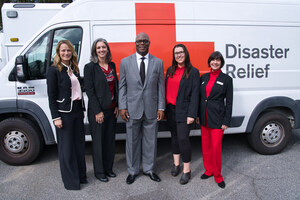WASHINGTON , Nov. 3, 2012 /PRNewswire-USNewswire/ -- The American Red Cross relief operation for Hurricane Sandy continues to grow each day, with more than 4,000 disaster workers providing shelter, food and relief supplies, particularly in hard-hit New Jersey and New York.
(Logo: http://photos.prnewswire.com/prnh/20090108/RedCrossLOGO)
"Our entire fleet of response vehicles and thousands of Red Crossers are on the ground helping people affected by Sandy," said Charley Shimanski, senior vice president of Disaster Services for the Red Cross. "We're driving through neighborhoods in all five boroughs in New York and parts of New Jersey to provide food, water, supplies and comfort.
"On Friday night, more than 12,800 people across nine states stayed in shelters. Of these, more than 6,100 were in Red Cross shelters in New Jersey, New York, Pennsylvania, Connecticut, Maryland, West Virginia and Ohio. Millions more are still without power, water or heat.
The large Red Cross operation in New Jersey and New York continues to build as more kitchens, fixed feeding sites and emergency aid locations are set up and response vehicles start making rounds in neighborhoods. So far, more than 275,000 meals and snacks have been provided in those two states alone.
Since Sandy began to affect the East Coast one week ago, the Red Cross has worked in 12 states, Washington, D.C., and Puerto Rico to help people in need. Over the past week, the Red Cross has—
- Served more than 398,000 meals and snacks;
- Provided more than 40,000 overnight stays in shelters;
- Provided more than 9,000 mental health and health consultations;
- Handed out more than 6,900 relief supplies; and
- Deployed more than 4,000 trained disaster relief workers to help.
RETURNING HOME As residents begin to return home, it is important they take steps to avoid potentially dangerous conditions. The Red Cross offers the following safety tips:
- Don't let anyone touch any electrical power lines, and report any downed lines to local officials.
- If you smell natural or propane gas or hear a hissing noise, leave immediately and call the fire department.
- Wear protective clothing, including rubber gloves and rubber boots.
- Check any food for spoilage and throw it out if exposed to temperatures higher than 40 degrees for two hours or more, or if it has an unusual odor.
- If food has been exposed to floodwaters, dispose of it.
- Avoid drinking or preparing food with tap water until you're sure it's not contaminated.
- If the power is still out, use flashlights—not candles—for light.
- Do not use a generator, grill, camp stove or other gasoline, propane, natural gas or charcoal-burning device inside a home, garage, basement, or any partially enclosed area. Locate the unit away from doors, windows and vents that could allow carbon monoxide to come indoors.
- Stay out of any building that has water around it.
- Watch animals closely and keep them under your direct control.
- Parts of your home may be collapsed or damaged. Approach entrances carefully. See if porch roofs and overhangs have all their supports.
- Materials such as cleaning products, paint, batteries, contaminated fuel and damaged fuel containers are hazardous. Check with local authorities for assistance with disposal to avoid risk.
- Inspect your home for damage. Take pictures of damage, both of the building and its contents, for insurance purposes.
HOW TO HELP The Red Cross response to Sandy is very large, and will be very costly. Those who want to help can make a donation to support American Red Cross Disaster Relief by visiting www.redcross.org, calling 1-800-RED CROSS (1-800-733-2767) or texting the word REDCROSS to 90999 to make a $10 donation. They can also use the "donate" feature on the free Red Cross Apps for mobile devices to support this relief response. Contributions may also be sent to local Red Cross chapters or to the American Red Cross, P.O. Box 37243, Washington, DC 20013.
PLEASE GIVE BLOOD More than 360 Red Cross blood drives have been cancelled due to the storm, representing a loss of as many as 12,000 blood and platelet products. People who are eligible, especially in places not affected by the storm, are asked to schedule a donation appointment in the days and weeks to come.
To schedule a donation time or get more information about giving blood, people can visit redcrossblood.org or call 1-800-RED CROSS (1-800-733-2767). To give blood, someone must be at least 17 years of age, meet weight and height requirements and be in general good health. Donors should bring their Red Cross blood donor card or other form of positive ID with them. Some states allow 16-year-olds to give with parental consent.
LET LOVED ONES KNOW People can let their loved ones know how they are by using the "I'm Safe" button on the Red Cross Hurricane App, or registering on the Red Cross Safe and Well website. The Hurricane App, which also contains safety tips on what people should do after the storm, can be found in the Apple App Store and the Google Play Store for Android by searching for American Red Cross. To register on Safe and Well, visit www.redcross.org or call 1-800-RED CROSS (1-800-733-2767).
RED CROSS SHELTERS To find a Red Cross shelter, download the Red Cross Hurricane App, visit the Red Cross website, call 1-800-RED CROSS (1-800-733-2767) or check local media outlets.
About the American Red Cross:
The American Red Cross shelters, feeds and provides emotional support to victims of disasters; supplies about 40 percent of the nation's blood; teaches skills that save lives; provides international humanitarian aid; and supports military members and their families. The Red Cross is a not-for-profit organization that depends on volunteers and the generosity of the American public to perform its mission. For more information, please visit redcross.org or join our blog at http://blog.redcross.org.
SOURCE American Red Cross
WANT YOUR COMPANY'S NEWS FEATURED ON PRNEWSWIRE.COM?
Newsrooms &
Influencers
Digital Media
Outlets
Journalists
Opted In




Share this article